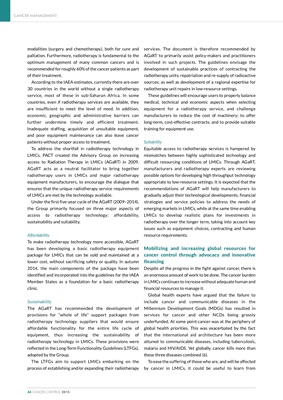
modalities (surgery and chemotherapy), both for cure and
palliation. Furthermore, radiotherapy is fundamental to the
optimum management of many common cancers and is
recommended for roughly 60% of the cancer patients as part
of their treatment.
According to the IAEA estimates, currently there are over
30 countries in the world without a single radiotherapy
service, most of these in sub-Saharan Africa. In some
countries, even if radiotherapy services are available, they
are insufficient to meet the level of need. In addition,
economic, geographic and administrative barriers can
further undermine timely and efficient treatment.
Inadequate staffing, acquisition of unsuitable equipment,
and poor equipment maintenance can also leave cancer
patients without proper access to treatment.
To address the shortfall in radiotherapy technology in
LMICs, PACT created the Advisory Group on increasing
access to Radiation Therapy in LMICs (AGaRT) in 2009.
AGaRT acts as a neutral facilitator to bring together
radiotherapy users in LMICs and major radiotherapy
equipment manufacturers, to encourage the dialogue that
ensures that the unique radiotherapy service requirements
of LMICs are met by the technology available.
Under the first five-year cycle of the AGaRT (2009-2014),
the Group primarily focused on three major aspects of
access to radiotherapy technology: affordability,
sustainability and suitability.
Affordability
To make radiotherapy technology more accessible, AGaRT
has been developing a basic radiotherapy equipment
package for LMICs that can be sold and maintained at a
lower cost, without sacrificing safety or quality. In autumn
2014, the main components of the package have been
identified and incorporated into the guidelines for the IAEA
Member States as a foundation for a basic radiotherapy
clinic.
Sustainability
The AGaRT has recommended the development of
provisions for "whole of life" support packages from
radiotherapy technology suppliers that would ensure
affordable functionality for the entire life cycle of
equipment, thus increasing the sustainability of
radiotherapy technology in LMICs. These provisions were
reflected in the Long-Term Functionality Guidelines (LTFGs),
adopted by the Group.
The LTFGs aim to support LMICs embarking on the
process of establishing and/or expanding their radiotherapy
services. The document is therefore recommended by
AGaRT to primarily assist policy-makers and practitioners
involved in such projects. The guidelines envisage the
development of sustainable practices of contracting the
radiotherapy units; repatriation and re-supply of radioactive
sources; as well as development of a regional expertise for
radiotherapy unit repairs in low-resource settings.
These guidelines will encourage users to properly balance
medical, technical and economic aspects when selecting
equipment for a radiotherapy service, and challenge
manufacturers to reduce the cost of machinery; to offer
long-term, cost-effective contracts; and to provide suitable
training for equipment use.
Suitability
Equitable access to radiotherapy services is hampered by
mismatches between highly sophisticated technology and
difficult resourcing conditions of LMICs. Through AGaRT,
manufacturers and radiotherapy experts are reviewing
possible options for developing high throughput technology
appropriate to low-resource settings. It is expected that the
recommendations of AGaRT will help manufacturers to
gradually adjust their technological developments, financial
strategies and service policies to address the needs of
emerging markets in LMICs, while at the same time enabling
LMICs to develop realistic plans for investments in
radiotherapy over the longer term, taking into account key
issues such as equipment choices, contracting and human
resource requirements.
Mobilizing and increasing global resources for
cancer control through advocacy and innovative
financing
Despite all the progress in the fight against cancer, there is
an enormous amount of work to be done. The cancer burden
in LMICs continues to increase without adequate human and
financial resources to manage it.
Global health experts have argued that the failure to
include cancer and communicable diseases in the
Millennium Development Goals (MDGs) has resulted in
services for cancer and other NCDs being grossly
underfunded. At some point cancer was at the periphery of
global health priorities. This was exacerbated by the fact
that the international aid architecture has been more
attuned to communicable diseases, including tuberculosis,
malaria and HIV/AIDS. Yet globally, cancer kills more than
these three diseases combined (6).
To ease the suffering of those who are, and will be affected
by cancer in LMICs, it could be useful to learn from
CANCER MANAGEMENT
44 CANCER CONTROL 2015